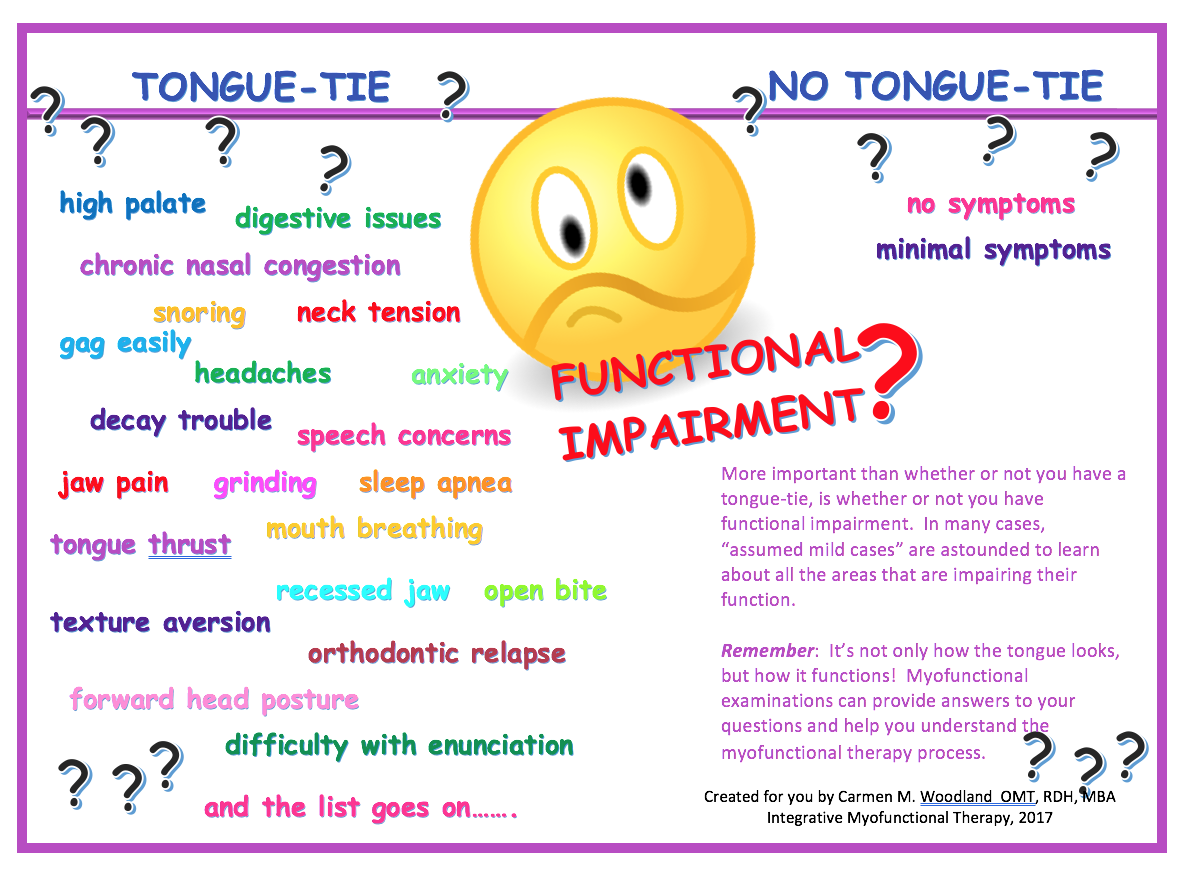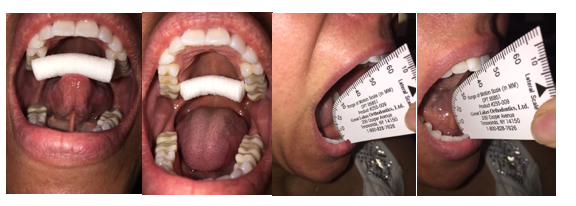

Functional impairment? Myofunctional impairment. I like the sound of that. As an orofacial myofunctional therapist (OMT), I spend a large amount of time educating and mentoring. I personally feel that I have such a responsibility to share my knowledge, and I take it very seriously. Early on in my private practice, I had to develop my treatment protocols and set my own benchmarks for what I believed in and how I chose to practice. One of those protocols I consistently challenge is the existence of a tongue-tie or not. I’m a member of many Facebook groups and also several private study groups etc. that talk about myofunctional disorders ad nausem. I just can’t get enough of it! But one thing disheartens me. When people place so much focus on whether or not they are tongue-tied. They post pictures and many people ooooh and ahhhhhh about how they most certainly are tongue-tied. Don’t get me wrong. I love that these people are asking. That means they are on the myofunctional radar. But what’s disheartening, is that these people do not have any idea, or little idea, about just how detrimental this tongue tie can be. Or even better. What if it’s not a tongue-tie? What if its myofunctional impairment? Does that mean they are A-ok? Does that little (ok, thick and short) band of tissue hold the power over whether a person has “the answer” or doesn’t have “the answer”?

WHAT IS MYOFUNCTIONAL IMPAIRMENT?
I like to illustrate myofunctional impairment with a simple example. Say, someone is in a car accident and injures their leg. They now have to walk with a limp. Should the person just accept the way they are because, after all, they can walk…even if it’s slow and hunched over with a limp? Or should that person try and figure out why they are this way and how they can improve or get rid of the problem?
To me, myofunctional impairment is anything that keeps you from firing on all pistons. Anything that keeps you from feeling great every day and living the way you want to live. The way we desire to live. Functional impairment is not allowing you to function fully. Meaning “you’re not broken but you could do better”. Does that make sense to you?
A person suffering from myofunctional impairment might have some of the following symptoms: nasal congestion and allergies; digestive issues; “mild” tongue-tie; relapsed orthodontic work; sucking habits; speech challenges, such as a lisp; chronic ear infections; snoring; sleep apnea; headaches; jaw pain; or poor posture…..but they’re just annoying symptoms. They’re just a big pain in the butt, but people have grown used to them. Should they really do something about them?
I’ve had multiple clients recently who score moderately on their severity assessment test. These clients might only have three or four different areas of symptoms, but they’re nagging, annoying ones. The neck and shoulders that just won’t take a chiropractic adjustment. The neck and jaw that just won’t respond to physical therapy. How about those with a lifelong inability to say “purple” (instead saying “poo poo”)? Their doctors may not think that they have a difinitive tongue-tie, but once the patient shares the laundry list of concerns, the doctor understands the need for treatment.
This is another reason I encourage my clients to have a comprehensive myofunctional evaluation before seeing the provider. Looking that provider in the eye and knowing exactly why you want a frenectomy is the only way to go. And it actually makes it easier on the provider, because you can state your reasons for needing a frenectomy and the provider knows that you have done your homework.

YOUR EYES ONLY SEE WHAT YOUR MIND KNOWS
Ignorance is not bliss! Knowledge is king! A person has no idea what is wrong with them until someone with knowledge educates them. This is where I come in. Whether I am seeing a client in my private myofunctional practice, Integrative Myofunctional Therapy, or whether I am wearing my RDH hat, I feel an obligation to let the patient know what I see. Many of them have no idea they have something keeping them from awesomeness. Some do but just assumed that they were “normal, abnormal”. They have no idea there is a treatment and the look in their eyes when the lightbulb comes on always makes it worth having the difficult conversation.
Lesson learned….have the conversation. If you’re struggling to have that conversation with someone. Have it. Please.
TONGUE-TIE CONFUSION
Is the answer really black and white? No, in my experience it’s certainly not. You cannot diagnose a tongue-tie on appearance alone. The tongue and its function must be thoroughly evaluated. Also, the tongue-tie doesn’t have to be severe to be causing impairment. The tongue may appear totally normal but…..
- Can the tongue be lifted up?
- Can the tongue move side to side?
- What about the back of the tongue?
- Is there a tongue thrust present?
- Is there a loss of range of motion?
- Can the tongue be stuck out?
Going back to the old childhood saying…”Don’t judge a book by its cover”……..”Don’t only judge a tongue by its frenum”.
WHERE DO I LEARN MORE?
You can browse my website for more information. I also offer, free 30-minute phone consultations to introduce myself and help answer your questions. This free consult can help you decide if you want to move forward to the comprehensive exam. Just drop me an email and I’d be happy to give you more direction for information.
If any of the above issues resonate with you or someone you know, I encourage you to contact me. I have programs to fit a range of people and I would love to see how I can help you out!

